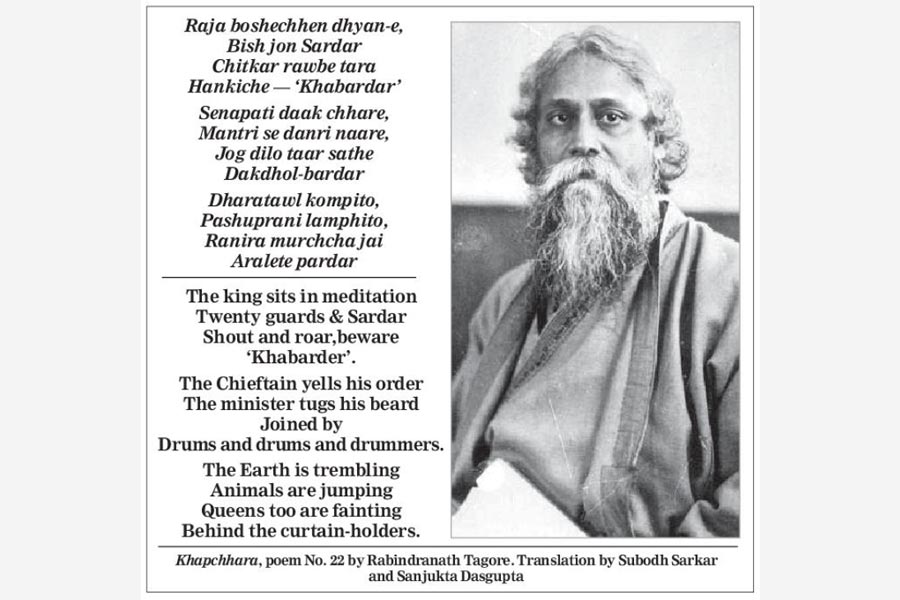A satirical verse of Rabindranath Tagore became a talking point on social media through the day as netizens found striking similarities between the theme of Raja Bosechen Dhyan-e (The King sits in Meditation) and Prime Minister Narendra Modi’s 45-hour meditation at the mid-sea Vivekananda Rock Memorial in Kanyakumari.
Modi began his meditation on Thursday evening after offering special prayers at Sri Bhagavathi Amman Temple in Tamil Nadu.
The verse, shared by multitude of Bengali-speaking people in different parts of the country and beyond, was part of Tagore’s book of verses Khapchara (Incongruity or Mismatch).
The verse was about a king embarking on meditation with royal guards, senior ministers and commanders all around. Dripping in satire, the poem highlighted how the king turned his meditation into a show of royal pomp (See translation by poet Subodh Sarkar, a recipient of the prestigious Sahitya Akademi Award and Sanjukta Dasgupta, former head, department of English, Calcutta University).
Talking to this newspaper, Sarkar said that he was not surprised with the netizens drawing parallels between Modi’s meditation, which became a national spectacle and a political issue, and Tagore’s verse, written about 87
years ago.
“The poem, which seems
to have been a humourous one, is now, due to a historical twist, a scathing satire
on the buffoonery of a king. Can India afford to have a meditation so gorgeous and expensive?” asked Sarkar, before asking what utility it would serve.
“The Prime Minister’s announcement of his 45-hour long meditation at Kanyakumari is not going to bring any jobs to the millions of jobless young citizens of India or solve the problems that the country is grappling with... Why this pomposity around the meditation exercise?” Sarkar wondered.
The grandeur around the meditation of Modi, who had undertaken a similar
exercise in a Kedarnath
cave after the 2019 poll campaign, was so apparent as a posse of 2,000 police personnel and various security agencies — like the Indian Coast Guard and the Indian Navy — maintained a tight vigil around Dhyan Mandapam. Swami Vivekananda, whom Modi considers his idol, as a young monk, had meditated in the same place in 1892 after which he had resolved to dedicate his life to serve humanity.
In Khapchara, the verse in question, The King Sits in Meditation, is the 22nd.
Several researchers termed Khapchara as a ‘nonsense verse collection’, which was a product of both the Western and Indian traditions.
“Khapchara was written at a time that was characterised by growing inequality in the urban spaces like Calcutta due to colonial rule... The complexities and the dialectics in the society and the problems were captured in a satirical manner in the verses, which captured issues like the idleness of the Babus or the pitfalls of the colonial system,” Manan Kumar Mandal, director, school of humanities, Netaji Subhas Open University, explained the theme of Khapchara.
“In this collection of disjointed verses, the Bard portrayed the characters using humour and fun besides offering a critique of the mindset of the people of the time,” he added.
This is not the first time that a Tagore’s verse has been invoked to mock Modi and his way of creating a cult around him. Ahead of the Ram temple consecration at Ayodhya in January, Tagore’s 1923 poem Deeno Daan had been widely circulated on social media. As a conscience-keeper for the nation and true Hinduism, Tagore had, in the poem, interrogated a monarch through a monk over an ostentatious, opulent shrine to a deity that was consecrated.
The monk had spoken the truth in the face of the monarch’s fury and boastful claims. The monk had said the temple was built with empty religiosity, sans genuine spirituality, when millions suffered because of a drought and had been impoverished without food and shelter.










